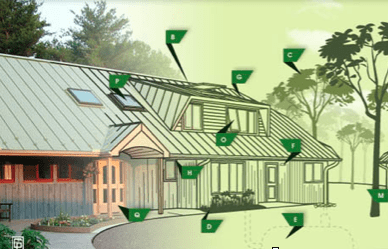Sustainable Design and Green Building Standards Revised

With energy resources depleting at an alarming rate, architects and engineers worldwide have realized the need to have energy and sustainable building design to ensure that a structure is eco-friendly and energy efficient.

Image Credit: http://www.cearchitects.com/green/index.php
The U.S. Green building Council and Illuminating Engineering Society recently came up with stricter water-use and energy-efficiency requirements to further reduce a buildings environmental impact in the latest version of the green building standard.
These standards address areas such as site sustainability, water-utilization and energy efficiency, qualitative indoor environment, and the overall impact of building on the various external factors like atmosphere, materials and resources.
The recent changes included 67 additions, which clearly reflect upon the transformation made through a public review process.
Some of the major changes include:
Energy: Noteworthy updates are included to ponder over the publication of Standard 90.1-2013, consisting of revised building requirements. Fenestration orientation prerequisites are revised as part of new research, as well as changes and revisions are made in the equipment efficiency tables, Energy Star references and constant air-barrier requirements.
Energy Performance, Emissions of Carbon Dioxide, and Renewables: Changes and explanations are included in the latest version to signify the changes to Standard 90.1. In this version, various Carbon dioxide emission factors through diversified energy sources are updated.
Indoor Environmental Quality: The quality of lighting was a new addition in the scope of this section, along with the requirements for lighting controls in particular space types. Moreover, conditions for air sealing of purification and air-cleaning equipment are stated, along with fresh requirements for preoccupancy ventilation as well as building envelope moisture management.
Site Sustainability: All site requirements are now made compulsory under the version, with prescriptive and performance choices moved to the mandatory requirements. Prerequisites for storm water management are emphasized, and fresh requirements are added to make space for bicycle parking and preferred parking for low-emission, hybrid or electric vehicles. Some fresh requirements also are added for the predesign valuation of native and aggressive plants.
Water: Extra water use requirements are added in this version. It states the requirements for lowering water consumption in a prudent manner for toilets, clothes washers, dishwashers as well as green roofs.
Impacts of Building on the Atmosphere, Materials, and Resources: Here requirements are revised for areas to store and gather recyclables, consisting of batteries and electronics. Requirements also are upgraded for management of construction waste along with life-cycle assessment. Further, new requirements are included for multiple-attribute product declaration or certification.
Construction and Plans for Operation: Prerequisites related to environmental impacts linked with idling construction vehicles are revised. Fresh requirements are made to mitigate the entry of airborne pollutants in connection with construction areas.
In the end, since the concept of green and clean energy is gaining pace, Sustainable Design and Green Building has become the code of the day!
About Bhushan Avsatthi
Bhushan Avsatthi is an Associate Director at Hi-Tech Outsourcing Services. Bhushan is a Consultant, BIM expert and a green building advisor with more than 15 years of industry experience. Bhushan imbibes the prophecy of efficient and prudent use of energy in his day to day life and advices his team to do so as well. He is also involved in green initiatives like nonprofit tree plantation project and promotes using bicycles for commuting small distances. Bhushan, handles a team of architects, structural and MEP engineers, LEED consultants and energy modeling experts.


